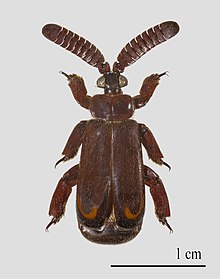Erich Wasmann
Erich Wasmann (born May 29, 1859 in Meran ; † February 27, 1931 in Valkenburg aan de Geul , Netherlands ) was a Jesuit and entomologist who mainly dealt with state-building insects and advocated a Christian science as a popular science author.
Life
His father was the painter Friedrich Wasmann .
Wasmann was a student at the Stella Matutina Jesuit college in Feldkirch in Vorarlberg. There he joined the Jesuit order. In 1875 he moved to a novitiate of the order in Exaten (Limburg province, Netherlands), later he moved to a college in Wijnandsrade. One of his teachers was the Jesuit father Ludwig Dressel . Due to poor health, he did not take up the priesthood, but became editor of the Jesuit cultural magazine Voices from Maria Laach . Wasmann was without an academic position all his life and never became a university professor. Inspired by a book by the British naturalist John Lubbock , he began to study ants. He was particularly interested in the myrmecophilic animal species in ant nests, later also in termite nests, about which he published several hundred scientific publications over the decades. His classification of the myrmecophiles still serves as the basis today. In 1891 Wasmann moved to Vienna, where he studied at the university without obtaining a degree, later he moved back to Exaten. Among his students there was the entomologist and Jesuit Hermann Schmitz . Wasmann published on instinct and intelligence in the animal kingdom and fought against Albrecht Bethe's reflex theory . In 1899 he moved to Luxembourg, where the editorial staff of his magazine had moved. Together with William Morton Wheeler , he managed to solve the biological mystery of the slave-owner ants .
In his textbook, Modern Biology and Developmental Biology , Wasmann placed his findings in the context of Darwin's theory of evolution, which at that time was still rejected by many in the Catholic Church. But he remained cautious and avoided applying the theory to humans. But he strongly advocated the Darwinian theory of descent, which recognizes the common descent of living beings from a parent form, in contrast to the constancy of species. Wasmann tried to prove the compatibility of Christian doctrine and evolution theory in a “Christian monism”, and came into sharp opposition to more decisive (also social) Darwinists like Ludwig Plate and Ernst Haeckel . In 1911 Wasmann moved to the Valkenburg Jesuit College in the Netherlands, where he lived until his death. He was into mimicry ; a special case of Bates' mimicry, the resemblance of guest ants to their host ants, is sometimes called "Wasmannian mimicry" after him.
Wasmann fought against the instrumentalization of the theory of evolution for the purpose of anti-religious propaganda by Ernst Haeckel and at the same time took the view that it could be brought into harmony with the teaching of the Roman Catholic Church . In 1907 Wasmann faced his critics in a spectacular public discussion in the Berlin Zoological Garden. The event represented a “new stage in the history of popularization”.
The natural philosopher Bernhard Bavink said that Wasmann contributed most on the Catholic side to the fact that "the resistance that the whole doctrine of descent found, especially in church circles, was largely abandoned".
Fonts (selection)
- Modern biology and the theory of development , 3rd, heavily probable edition, Freiburg im Breisgau [u. a.]: Herder, 1906
- Ludwig Plate : (Ed.): Ultramontane Weltanschauung and modern life studies, orthodoxy and monism: the views of the Jesuit father Erich Wasmann and the speeches held against him in Berlin , Verlag Gustav Fischer, Jena 1907
literature
- AJ Lustig: Erich Wasmann, Ernst Haeckel, and the limits of science. In: Theory in Biosciences Volume 121, Number 3 / November, 2002
- Heike Baranzke: Erich Wasmann (May 29, 1859 - February 27, 1931) - Jesuit and zoologist in personal union . In: Yearbook for the History and Theory of Biology , Vol. 6, ed. v. Michael Weingarten, Matthias Gutmann, Eve-Marie Engels. Publishing house for science and education. Berlin 1999, 77-139, ISBN 3-86135-363-6 , ISSN 0944-3266 .
- Heike Baranzke / Elias Prieth: Two forgotten Merano sons. In the footsteps of the painter Friedrich Wasmann and his famous son Erich. In: The Sciliar. Monthly magazine for South Tyrolean regional studies vol. 70, Bozen 1996, vol. 6, 347–355.
- Andreas W. Daum : Science popularization in the 19th century. Civil culture, scientific education and the German public, 1848–1914 . 2nd, supplementary edition, Oldenbourg, Munich 2002, ISBN 978-3-486-56551-5 .
- Hermann Schmitz (1932): In memoriam P. Erich Wasmann. SJ Tijdschrift voor Entomologie 75 (1): 1-57.
Web links
- Literature by and about Erich Wasmann in the catalog of the German National Library
Individual evidence
- ^ Andreas W. Daum: Science popularization in the 19th century. Civil culture, scientific education and the German public, 1848–1914 . Oldenbourg, Munich 2002, p. 229 .
- ^ B. Bavink: Results and problems of the natural sciences. An introduction to today's natural philosophy. Leipzig 1924. 389.
| personal data | |
|---|---|
| SURNAME | Wasmann, Erich |
| BRIEF DESCRIPTION | Austrian Jesuit and entomologist |
| DATE OF BIRTH | May 29, 1859 |
| PLACE OF BIRTH | Meran |
| DATE OF DEATH | February 27, 1931 |
| Place of death | Valkenburg aan de Geul (Netherlands) |

